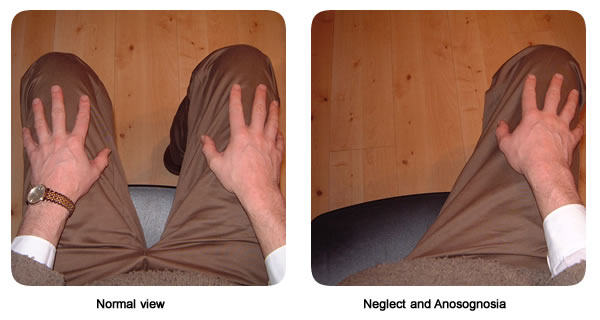Hemispatial neglect, also known as left neglect, results most commonly from brain injury to the right cerebral hemisphere and causes visual neglect of the left hand side of space. When half of your visual field is lost, half of the world is gone. The consequences of neglect can range from humorous to devastating, but one thing is certain, compensation will be necessary during the recovery process. Here are a few tips from the pros.
Persons with neglect are at a higher risk for accident, injury and fall. Take precautions to increase safety and awareness.
Use a wheelchair tray or trough when seated; use a sling or other positioning device when walking
- prevents subluxation of the shoulder
- prevents injury to the arm, hand, elbow
- keeps the limb visible
- increases body awareness
Outline doorways with bright tape
- increases environmental awareness
- provides a point of reference when seeking the left visual field
- prevents collision and injury with door frames
- increases safety
- reduces risk for fall
Clear the way
- eliminate necessary obstacles on the left side
- provide clear, clutter free paths
- offer verbal and visual cues as needed
Stand or walk next to the person on their affected side
- encourages them to look and scan to the left
- enables you to steer them away from obstacles
- increases safety- reduces risk of colliding, tripping or falling
Left Sided Neglect and Meal Time
Not only will persons with visual neglect eat only half of the food on their plate, they will not be aware of things on the left side of the table. It is important to consider the entire dining environment. Small changes can make a big difference.
- Place napkin, utensils, beverages and yummy deserts on the left side of the table
- Rotate the plate during the meal to ensure all food is consumed
- Sit on the person's left side to draw their attention that way
- Use hand over hand techniques to facilitate use of left hand, when appropriate
- Give verbal and tactile cues as needed
- Tape a line down the center of the table or tray where the meal is being served
- Avoid distractions and eliminate clutter
Left Sided Neglect and Activities of Daily Living
Neglecting half of the body can be problematic when considering hygiene and dressing. Compensatory strategies to the rescue!
- Dress, shave or wash the left side of the body first and then the right
- Encourage the use of the left hand as much as possible
- Label drawers to indicate contents within
- Place all necessary items to complete the task to the left
- Use a mirror to provide feedback
- Provide verbal and tactile cues as needed
- Eliminate distractions
- Reduce clutter
- Limit choices
Additionally, there is a tremendous variety of adaptive equipment to make life easier for the person with hemiplegia and associated visual neglect. Occupational therapists are the experts here and can assist with selecting appropriate devices or pieces of equipment
Try to let the person do as much as they can for themselves. It may be easier and save time for you to do the task, but the person will become less independent unless they try to do tasks on their own.
Left Sided Neglect and the EnvironmentTry to let the person do as much as they can for themselves. It may be easier and save time for you to do the task, but the person will become less independent unless they try to do tasks on their own.
Retraining an individual to attend to the left side of their world takes time and persistence. Consistent attention to the left, even during leisure activities or when visiting with a friend, can speed the recovery process.
Place frequently used items or objects on the left
- remote control
- glasses
- water
- phone
Position bed to encourage looking toward windows and doorways
Position TV or radio on the left
Sit on the left side of the person
To avoid startle, approach from the right
Reading and writing abilities can be significantly limited by changes in the visual field. External cues and simple modifications are helpful.
- Draw a brightly colored line down the left side of the page- cue to use as a reference point for finding the left margin
- Use a ruler, index card or blank piece of paper to follow the lines of text
- Number the lines in order to follow proper sequence and avoid skipping
- Follow along using a finger
- Use enlarged print or double spacing
- Cue and prompt as needed
Neglect affects all aspects of a person's life. Encourage families and caregivers to learn more about ways they can assist in recovery. Incorporating compensatory strategies during the rehabilitation process can increase awareness, safety and ultimately, independence.
Helping a person will not necessarily change the world, but it will change the world for that person.
Unknown












